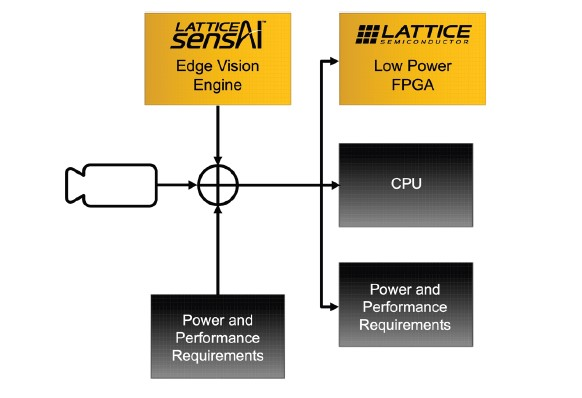[Blog] Powering Real-Time HMI with Lattice’s Edge Vision Engine
Posted 07/22/2025 by Hussein Osman, Segment Marketing Director, Lattice Semiconductor
In the past, Human Machine Interface (HMI) were relatively simple, consisting of buttons, knobs, levers, and static displays designed to control basic functions. Today, HMIs have evolved into sophisticated, context-aware systems that serve as the primary bridge between users and increasingly intelligent machines. Whether embedded in vehicles, Industrial equipment, consumer electronics, or smart infrastructure, modern HMIs must manage a growing array of tasks. These include real-time data visualization, voice interaction, biometric authentication, and AI-driven automation. These systems are expected to be intuitive, responsive, and secure, all while operating within tight power, space, and performance constraints.
At the core of this evolution are dynamic, multimodal HMI platforms powered by advanced hardware and software solutions, such as those enabled by Lattice low power Field Programmable Gate Arrays (FPGAs) and the Lattice sensAI™ solution stack.
The Shift Towards Adaptive Human-Machine Interfaces
As digital systems become more intelligent and interconnected, HMIs must evolve to keep pace. These interfaces are no longer just control panels; they are intelligent gateways that interpret user intent and system context in real time. Whether in a vehicle, a factory, or a smart home, modern HMIs must deliver seamless, intuitive interactions while managing increasingly complex data and functionality.
This shift requires a new generation of hardware and software solutions that can support real-time responsiveness, adaptability, and low power consumption. In many cases, HMIs must process data from a wide range of sensors in real time, including cameras, motion detectors, microphones, and environmental monitors.
To meet these demands, modern HMIs increasingly rely on artificial intelligence (AI) and machine learning (ML) to interpret inputs and deliver responsive, context-aware experiences. This requires robust hardware and software capable of performing sensor fusion, managing data streams, and supporting intelligent decision-making at the edge. Building such systems calls for specialized components designed to support high-performance, adaptive HMI applications across a wide range of industries.
The Role of sensAI in HMI Builds
The Lattice sensAI solution stack is designed for low power, small footprint FPGA-based AI and ML applications, like those needed at the far edge or in near-sensor devices. It combines FPGA hardware, software tools, and IP cores to enable AI inferencing on embedded systems like Automotive HMIs. The sensAI Edge Vision Engine is a solution designed specifically to support advanced computer vision (CV) capabilities in HMI systems.
 Lattice sensAI Edge Vision Engine: Hardware optimized algorithms
Lattice sensAI Edge Vision Engine: Hardware optimized algorithms
Lattice sensAI’s pre-built CV/ML models deliver cutting-edge computer vision features optimized for real-time performance such as:
- Face and body detection, which accurately identifies and tracks facial expressions and body movements to support safety features like auto-breaking, attention tracking, and more.
- Face and voice identification, which recognizes and verifies individuals through their facial features or vocal patterns to enhance security, enable personalization, and mitigate distractions.
- Gaze tracking, which detects and interprets eye movements to enable intuitive, precise hands-free interactions.
- Object detection, which tracks objects in real-time for enhanced situational awareness.
These AI and ML models can also support HMI enhancements in various industries and settings, helping to simplify interfaces in manufacturing and industrial facilities. Hands-free controls, CV-supported camera systems, and face and body detection capabilities can improve accuracy, response times, and accessibility to protect workers and operations. Face and voice identification tools can also help tighten controls within high-risk or high-security buildings and areas.
Lattice sensAI-powered HMIs also offer improved functionality for the next generation of consumer electronics. Voice and gesture-based UIs will be key to unlocking in-demand smart home security and personalization features. Meanwhile, human presence detection and continuous face identification tools can revolutionize self-service safety at ATMs and other public-service-oriented equipment. Computer vision technology can verify identities via biometric identification methods, monitor users’ surroundings, and notify them of threats in real-time—or reach out to appropriate channels should the situation escalate.
The sensAI solution stack is optimized to balance power, performance, compatibility, scalability, and security. Its advanced computer vision models are specifically designed to perform with a wide variety of inference hardware, including Lattice’s extremely low power FPGAs and more resource-intensive options like x86 and Arm CPUs. Critically, these AI/ML models were built with developers in mind, offering full-stack support and cohesive development capabilities to expedite the development of tailored ML algorithms.
FPGAs for HMI
Though sensAI is built for interoperability and flexibility, engineers who leverage the engine in conjunction with systems built using Lattice FPGAs will see the most value due to the synergistic benefits they offer:
- Parallel processing capabilities: FPGAs can execute multiple operations simultaneously, enhancing the responsiveness and efficiency of HMI systems for quicker decision-making and smoother user experiences.
- Compact design: In devices and embedded systems, every millimeter counts; Lattice FPGAs’ small form factors allow for easy integration into various applications, making embedded system design simpler.
- Low power demand: Vehicles’ power supplies are limited, and designers must prioritize core functions first. As the low power programmable leader, Lattice FPGA’s power efficiency features ensure peak performance despite these constraints.
- High I/O capacity: Lattice FPGAs facilitate numerous input and output connections, which are vital for complex HMI systems.
- Reprogrammability and scalability: FPGAs are made to be updated and modified on the fly, ensuring HMI systems can adapt and scale alongside user requirements and technological advancements.
- Reliability: Lattice FPGAs are engineered for consistency and longevity, so users can rely on HMIs to continue to perform safely and correctly, today and tomorrow.
This blog only scratches the surface on this topic. If you’d like to dive deeper, download our white paper on this topic or the HMI applications enabled by Lattice sensAI Edge Vision Engine solution brief to learn more, and contact us to kick off your HMI application development journey.
For more information on Lattice’s edge AI and FPGA solutions, please visit Lattice Edge AI page.